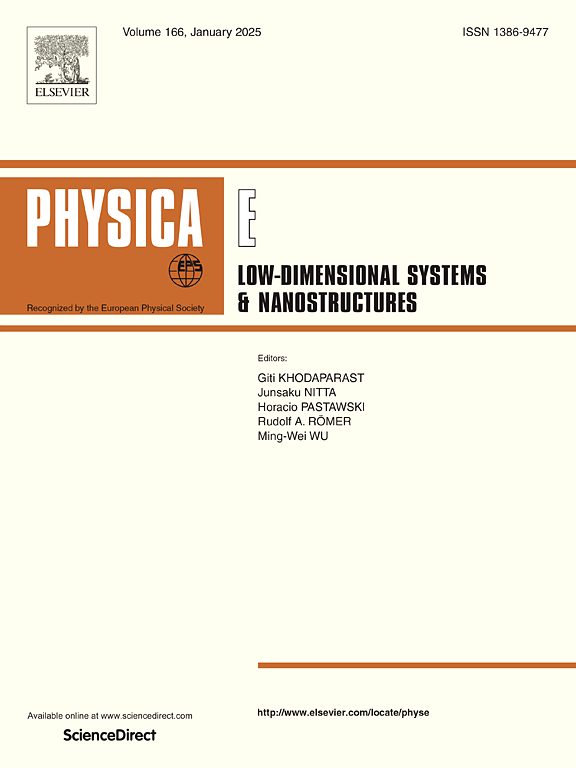Strain enhanced thermoelectric performance of Lu2CF2 MXene
IF 2.9
3区 物理与天体物理
Q3 NANOSCIENCE & NANOTECHNOLOGY
Physica E-low-dimensional Systems & Nanostructures
Pub Date : 2025-02-01
DOI:10.1016/j.physe.2024.116168
引用次数: 0
Abstract
The thermoelectric performance of LuCF MXene monolayer under biaxial tensile strain is explored using the first-principles method and Boltzmann transport theory. Biaxial strain enhances the electron–phonon relaxation time, leading to elevated electrical conductivity and increasing the thermoelectric power factor (PF). Specifically, the PF of n-type LuCF rises from 4.6 mW/mK2 to 13.7 mW/mK2 when subjected to a 4% biaxial tensile strain at 700 K, showing an almost threefold increase. Similarly, for p-type, the PF increases to 8.2 mW/mK2 from 3.9 mW/mK2, which is more than double. The modulation of lattice thermal conductivity () also occurs under tensile strain conditions. The at 300 K, also decreases to 16.2 Wm−1K−1 from 88 Wm−1K−1 under 6% tensile strain, indicating an approximately 81.5% reduction. The combination of higher PF and lower results in a significant enhancement in the thermoelectric figure of merit (ZT), increasing it from 0.07 to 0.68 for n-type and from 0.06 to 0.63 for p-type at 700 K. The ZT sees an almost tenfold increase compared to the strain-free scenario, indicating that biaxial tensile strain can effectively enhance the thermoelectric efficiency of the monolayer of LuCF.
应变增强lu2cf2mxene的热电性能
利用第一性原理方法和玻尔兹曼输运理论,研究了lu2cf2mxene单层材料在双轴拉伸应变下的热电性能。双轴应变增加了电子-声子弛豫时间,导致电导率升高和热电功率因数(PF)增加。具体来说,在700 K下,当受到4%的双轴拉伸应变时,n型Lu2CF2的PF从4.6 mW/mK2上升到13.7 mW/mK2,几乎增加了三倍。同样,对于p型,PF从3.9 mW/mK2增加到8.2 mW/mK2,增加了一倍多。在拉伸应变条件下,晶格热导率(κl)也发生调制。在6%的拉伸应变下,300 K时的κl也从88 Wm−1K−1降低到16.2 Wm−1K−1,降低了约81.5%。高PF和低κl的组合显著提高了热电性能系数(ZT),在700 K时,n型的ZT从0.07提高到0.68,p型的ZT从0.06提高到0.63。与无应变情况相比,ZT几乎增加了10倍,这表明双轴拉伸应变可以有效提高Lu2CF2单层的热电效率。
本文章由计算机程序翻译,如有差异,请以英文原文为准。
求助全文
约1分钟内获得全文
求助全文
来源期刊
CiteScore
7.30
自引率
6.10%
发文量
356
审稿时长
65 days
期刊介绍:
Physica E: Low-dimensional systems and nanostructures contains papers and invited review articles on the fundamental and applied aspects of physics in low-dimensional electron systems, in semiconductor heterostructures, oxide interfaces, quantum wells and superlattices, quantum wires and dots, novel quantum states of matter such as topological insulators, and Weyl semimetals.
Both theoretical and experimental contributions are invited. Topics suitable for publication in this journal include spin related phenomena, optical and transport properties, many-body effects, integer and fractional quantum Hall effects, quantum spin Hall effect, single electron effects and devices, Majorana fermions, and other novel phenomena.
Keywords:
• topological insulators/superconductors, majorana fermions, Wyel semimetals;
• quantum and neuromorphic computing/quantum information physics and devices based on low dimensional systems;
• layered superconductivity, low dimensional systems with superconducting proximity effect;
• 2D materials such as transition metal dichalcogenides;
• oxide heterostructures including ZnO, SrTiO3 etc;
• carbon nanostructures (graphene, carbon nanotubes, diamond NV center, etc.)
• quantum wells and superlattices;
• quantum Hall effect, quantum spin Hall effect, quantum anomalous Hall effect;
• optical- and phonons-related phenomena;
• magnetic-semiconductor structures;
• charge/spin-, magnon-, skyrmion-, Cooper pair- and majorana fermion- transport and tunneling;
• ultra-fast nonlinear optical phenomena;
• novel devices and applications (such as high performance sensor, solar cell, etc);
• novel growth and fabrication techniques for nanostructures

 求助内容:
求助内容: 应助结果提醒方式:
应助结果提醒方式:


